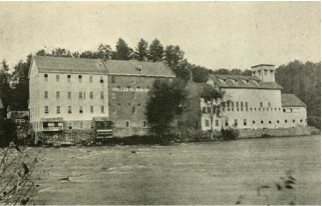
In 1893, his grandsons, Robert Lincoln Harris and Almon Greene Harris made extensive improvements to the mill and incorporated it under the name Dustin Island Woolen Mills. In 1906 Arthur B. Emery became a partner in the business and by 1911 had formed a new company, Harris-Emery Company, which then purchased the holdings of the Dustin Island Woolen Mills.
In 1820, a sawmill was built a short distance downstream from that first gristmill on a site that would one day become the Stratton & Company flourmill. It’s owners; William and Richard Gage, Job and Timothy Abbott and John Eastman would operate the mill in turns. The Gages would run the mill for two weeks, then the Abbott’s for a week and then Eastman for a week.

At the turn of the 20th century the Stratton & Company mill was the largest flourmill in New England, producing three hundred barrels of flour and five hundred bushels of corn meal daily. The land and buildings of Stratton & Company were sold in 1953 to the Boscawen Development Corporation.
In 1942, Nathan Brezner acquired the old New Hampshire Spinning Mill on East Canal Street in Penacook and converted it to a modern tannery. The Brezner Tanning Corporation was New Hampshire’s largest and most successful tannery from its establishment in 1942 until 1987 when production ended at the facility. In 1952 the company was sold to the Allied Kid Company of Boston, a large conglomerate engaged in the manufacturing and tanning of goatskins, in Wilmington, Delaware. At the time of the Brezner purchase, Allied Kid had plans to expand production to include upper leather sides, a higher quality leather made from cowhides. To find the space necessary, the old Stratton & Company buildings and the Harris Emery Woolen Mill on Commercial Street were purchased. The Stratton property was used as a hide receiving station while the preparation of split leathers took place in the former Harris woolen mill.
In 1972 the Allied Kid Company and Brezner Tanning Corporation merged to become Allied Leather Company and by the mid 1970’s had become a part of the General Hose Company of New York. In 1978 Lowengart Corporation, a subsidiary of Feuer Leather Corporation of New York acquired Allied Leather. Through the early 1980’s millions of dollars was spent to increase production and modernize equipment, only to end in bankruptcy in 1987. Allied cited a tight labor market and state environmental regulation as reasons. The buildings were left abandoned for more than ten years during the bankruptcy proceedings.
On April 8, 1997 the Allied Leather Corporation filed a quitclaim deed transferring all Commercial Street properties and buildings to the Hannah Dustin Holdings, LLC.
Today the Town of Boscawen owns much of the property along the south side of Commercial Street.
